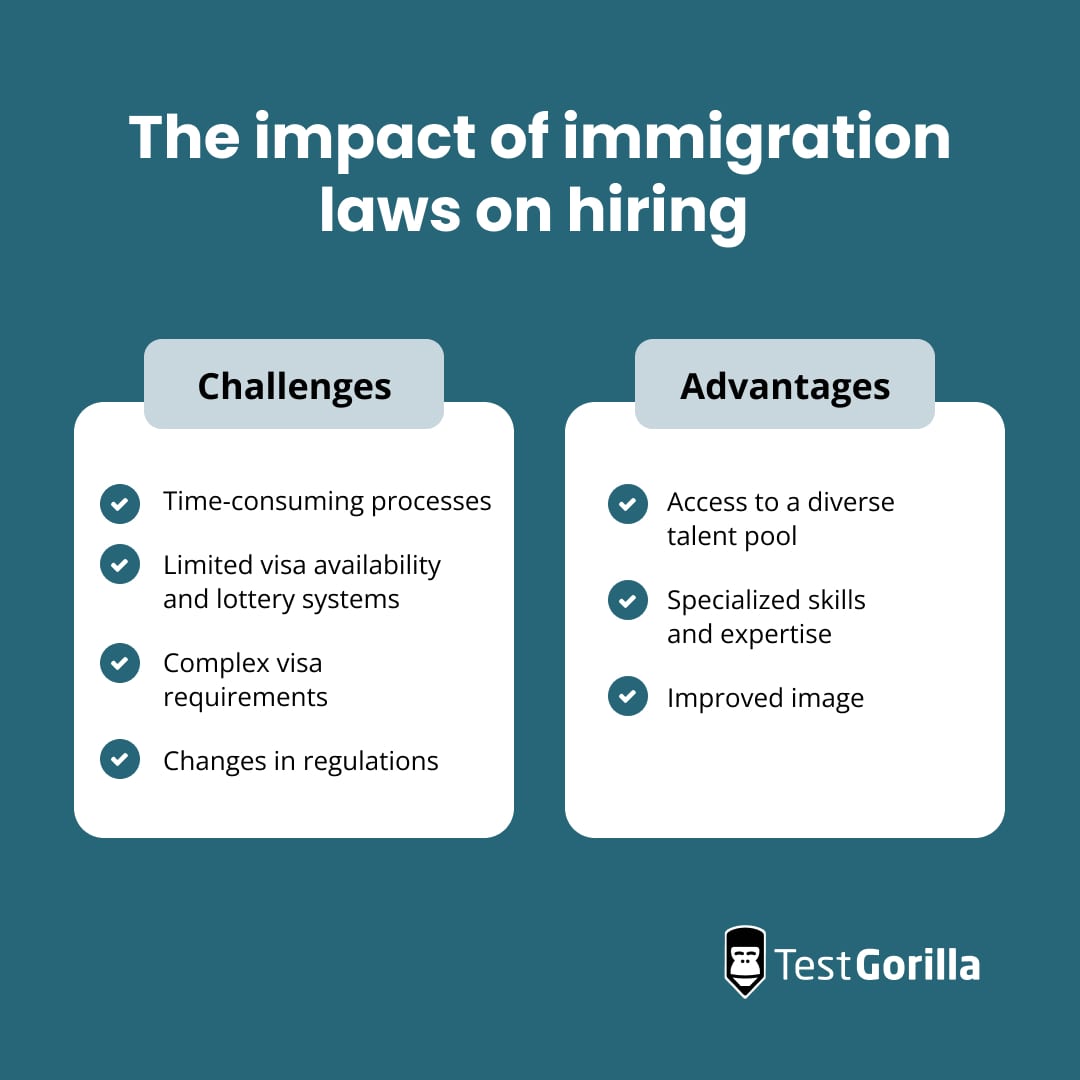Whether you’re hoping to hire immigrants from abroad or ensure you stay compliant with laws in your local hiring, immigration laws come into play.
Hiring in the US requires businesses to check work authorization status for all employees and treat immigrant employees equitably. Meanwhile, hiring from abroad can bring headaches – from choosing the right visa to navigating regulatory changes.
In this article, we highlight how immigration laws are already impacting your business and what you can do to streamline compliance efforts.
Table of contents
Understanding US immigration laws
Immigration laws in the US work toward three goals for employment:
validating an individual’s right to work in the country
creating pathways for immigrants to work in the country legally
protecting immigrants from discrimination
Here are the primary immigration laws you should know, along with information on how each impacts your hiring strategy.
Immigration and Nationality Act (INA)
This is the primary federal law governing immigration policy in the United States. The INA outlines visa categories, eligibility requirements, and processes for both immigrant and non-immigrant visas. A visa provides legal permission for a non-US citizen to live and work in the country. An employer, you can sponsor a non-US citizen under the INA – helping them gain legal permission to live and work in the US.
The INA also establishes employee protections for non-citizen workers. For example, it prohibits recruiting or hiring processes that exclude applicants based on their national origin. It also requires you to pay non-citizens at or above minimum wage levels, even if those non-citizens are in the country for temporary work.
Immigration Reform and Control Act (IRCA) of 1986
The IRCA prohibits you from knowingly hiring employees not authorized to work in the country. The best-known requirement to come out of the IRCA is Form I-9. This form requires employees to present approved identification documents to their employer to demonstrate their right to work in the US. Form I-9 includes sections you and your new hires must complete.
Title VII of the Civil Rights Act of 1964
Title VII isn’t strictly an immigration law, but it prohibits workplace discrimination – including discrimination based on national origin.
The Immigration Act of 1990
The Immigration Act of 1990 created the H-1B visa program and the employment-based immigrant visa categories. The H-1B visa program lets highly educated workers reside in the US and perform certain specialty occupations, often within technology, engineering, or medical science fields.
The H-1B Visa Reform Act of 2004
This law amended the INA by placing additional requirements on employers who seek to hire H-1B non-immigrant workers. For example, you must verify in writing that you’ve attempted to fill your open position with a US worker before hiring an immigrant. You also must prove that you’ll pay the worker at least the wage defined by the Department of Labor.
The impact of immigration laws on hiring
Hiring immigrant employees requires additional diligence and can be challenging – but the benefits can outweigh the challenges.
Challenges posed by immigration laws
Here are the main challenges immigration laws bring.
1. Time-consuming processes
The procedures involved in securing visas and work permits can be lengthy, leading to delays in onboarding valuable talent. For example, your candidate may need to interview at an embassy or consulate. Limited interview appointments might create significant delays.
Even when you hire locally, immigration laws impact your business. The IRCA requires you to include immigration checks in your onboarding process. Checking employee identification and completing Form I-9 is a required step when onboarding any employee in the US.
2. Limited visa availability and lottery systems
If you’re hiring an international employee from abroad, the restrictive nature of visa quotas can create uncertainty in your recruitment efforts. For example, the H-1B visa program often receives more visa applications than the government’s annual quota. When that happens, applications are placed in a lottery. This makes it hard to know whether your candidate’s application will be successful.
(Please note that this process doesn't apply to hiring international employees remotely, which involves its own set of regulations and considerations.)
A visa application rejection can upend your talent acquisition strategies. Unfortunately, planning ahead isn’t always possible if you must hire through a visa program with quotas attached.
Hiring an immigrant who’s already in the country requires consideration of their current immigration status and work authorization. For example, immigrants on H-1B work visas may require a visa transfer.
3. Complex visa requirements
Complying with immigration laws for visa-holders requires meticulous attention to detail. Visa applications and renewals often involve extensive paperwork – and missing a single piece of information can result in a lengthy back-and-forth. Deadlines are also strictly monitored, and missing one can result in an application rejection. The intricate nature of these requirements complicates the hiring process, sometimes extending it.
4. Changes in regulations
Immigration can be a hotly contested political issue, leading to policy shifts that follow the current government administration’s preferences. Frequent changes in immigration policies mean you’ll need to continuously adapt your recruitment strategy.
Advantages and opportunities for employers
Despite their challenges, immigration laws also present you with various benefits.
1. Access to a diverse talent pool
Hiring immigrants brings a wealth of perspectives, experiences, and cultural backgrounds that can benefit your business. For example, you can better position your business to enter new markets if you have employees already familiar with those areas.
A diverse workforce also sparks creativity and innovation while fostering an atmosphere where varied viewpoints contribute to problem-solving and strategic decision-making.
2. Specialized skills and expertise
Immigrant workers may possess unique skill sets and specialized expertise that can be challenging to find within your local talent pool. Using these specialized skills can help your business gain a competitive edge. This is particularly useful in industries requiring niche expertise, advanced technical knowledge, or specialized cultural understanding.
3. Improved image
When immigrant employees feel supported and valued, they often become strong advocates for the company. This in turn helps attract more diverse talent and bolters your brand image.
Strategies for employers
Deciding that you’d like to include immigrant talent in your hiring strategy is only the beginning. To capitalize on this opportunity, establish a plan for navigating immigration law requirements and setting up hiring and onboarding processes that are welcoming.
Navigate the complexities of immigration laws
Here’s how you can navigate the complexities of these laws.
Understand visa options
Before you can hire an immigrant employee, you must understand which visa types may be open to them. Understand the specific requirements, eligibility criteria, and limitations associated with each visa category.
Visas for employment purposes are separated into two main categories:
Non-immigrant visas. These visas, such as the H-1B, don’t provide a pathway to permanent residence in the US. They’re instrumental for businesses seeking temporary employment of foreign nationals with specialized skills. However, the limited availability and rigorous selection process present challenges for employers navigating these visas.
Immigrant visas. These visas, such as Green Cards and long-term employment-based visas, offer pathways for individuals to permanently reside and work in the US. As a result, they’re useful for attracting those with long-term career aspirations.
Understanding visa options enables you to identify the most suitable visa type while avoiding delays due to visa mismatches. You can achieve this by researching visas on your own or consulting with an immigration specialist.
Partner with immigration attorneys or consultants
Collaborating with immigration attorneys or consultants ensures you fully understand your options for employing immigrant workers. These experts can tailor guidance on visa processes, ensuring you aren’t caught unaware by changing regulations.
Immigration attorneys and consultants can also aid in strategizing the visa acquisition process. When obstacles arise, they may be able to help assist with smoother pathways that avoid unnecessary delays.
Develop an inclusive hiring strategy and supportive work environment
Ensure you comply with anti-discrimination rules and develop a work culture that encourages fair treatment for all of your employees.
Avoid discriminatory acts
Discriminating against an individual based on their national origin is illegal under both the INA and Title VII. Unlawful discrimination can occur even before an employee is hired. For example, the Department of Justice recently fined employers $1.6 million in penalties for posting job advertisements that stated they were willing to hire US citizens only.
Your managers must also avoid taking actions that could be perceived as discriminatory during the hiring process or beyond. For example, don’t fall prey to illegal interview questions about a candidate’s national origin. An individual’s national origin can’t be the basis for a business decision – whether in hiring decisions or employment actions like promotions or lay-off decisions.
Offer support and resources for immigrant employees
Moving to a new country is a huge step for employees. Providing tailored support networks and resources for immigrant employees can aid their smooth integration into the workplace.
Consider initiatives that help immigrant employees feel at home in their new environment. Common examples of successful programs include mentorship, language assistance, and buddy programs. Cultural sensitivity training for all employees can make the transition easier and help your local employees overcome stereotype-based beliefs.
Balance differences
Acknowledging and capitalizing on cultural diversity within your teams fosters an environment where employees view cultural differences as strengths rather than barriers.
Encourage open communication and team-building activities that celebrate diverse cultures. This will help promote collaboration, enhance creativity, and foster mutual understanding among team members.
Create an environment that supports diverse talent
Fostering an inclusive workplace culture aids your compliance efforts and helps immigrants feel valued and empowered. Achieve this by promoting diversity and inclusion initiatives, integrating diversity into your company values, and cultivating an atmosphere of respect and appreciation for various perspectives and backgrounds.
Adapt hiring processes for compliance and efficiency
Ensure your teams are able to work through legal requirements quickly and accurately.
Streamline visa application procedures
Build efficiency into your internal processes to minimize delays when applying for visas. Start by creating checklists for the documentation and application steps required for visas your business will pursue regularly. Use technology to organize documents and maintain clear communication channels with your candidates.
Ensure legal compliance in hiring
Ensure your HR and hiring teams understand immigration laws and supporting document requirements. Test your team members’ knowledge and provide training to fill gaps. You can also use skills-based testing to hire HR professionals already equipped with this knowledge.
TestGorilla is a skills-based testing platform that makes it easy to evaluate immigration knowledge. We have various skills tests that apply – from language proficiency to critical thinking tests. Ensure that your next HR hire will add the value you need to identify and secure immigrant talent.
Also, whether completing Form I-9 or a long-term employment visa application, your teams should maintain robust recruitment and visa records. This diligence will safeguard your company from legal pitfalls while ensuring compliant hiring practices.
Build compliant and inclusive teams with TestGorilla
Immigration laws impact various aspects of your hiring strategy – from writing your job ads to onboarding candidates. These laws determine who you can hire, how you can support them in obtaining work authorization, and the documentation you must maintain. While hiring immigrants is challenging, it brings many benefits – including specialized skills and long-term retention.
When you’re ready to tap into immigrant talent, TestGorilla can help your hiring process. Use skills-based testing to gain a full picture of each candidate and their ability to add to your business culture – even when they’re halfway around the world. Whether you need your new hire to work in English or any other languages, TestGorilla makes assessing language proficiency simple and objective.
Get started with TestGorilla for free, or take a product tour to see how skills-based hiring can improve your hiring process!
Related posts
Hire the best candidates with TestGorilla
Create pre-employment assessments in minutes to screen candidates, save time, and hire the best talent.
Latest posts
The best advice in pre-employment testing, in your inbox.
No spam. Unsubscribe at any time.

Hire the best. No bias. No stress.
Our screening tests identify the best candidates and make your hiring decisions faster, easier, and bias-free.
Free resources
This checklist covers key features you should look for when choosing a skills testing platform
This resource will help you develop an onboarding checklist for new hires.
How to assess your candidates' attention to detail.
Learn how to get human resources certified through HRCI or SHRM.
Learn how you can improve the level of talent at your company.
Learn how CapitalT reduced hiring bias with online skills assessments.
Learn how to make the resume process more efficient and more effective.
Improve your hiring strategy with these 7 critical recruitment metrics.
Learn how Sukhi decreased time spent reviewing resumes by 83%!
Hire more efficiently with these hacks that 99% of recruiters aren't using.
Make a business case for diversity and inclusion initiatives with this data.


















